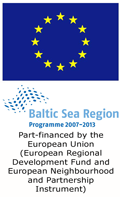Basic Project Information
The project has been granted under the “Priority1: Fostering Innovations“ of the Baltic Sea Region Programme 2007 – 2013. Co2ol Bricks started in December 2010 and runs until December 2013. During this time it has a total budget of 4,3 Mio, 18 partners from 9 countries with 9 languages will work together.
Project Description
The conservation of heritage, in particular historical buildings, is a common goal in the Baltic Sea Region (BR). Due to the common identity in the BSR it is very important to protect the historical buildings in order to preserve the individal characteristics and therewith the attractiveness and competitiveness of the cities around the Baltic Sea.
After the first wave of technical improvements like modern heating, thermal insulation and windows of a high thermal standard today incompatibilities with heritage and monument conservation affairs appear. On the one hand ancient, middle-aged or just historical precious cities, ensembles, monuments or buildings are a very important evidence of the BSRs cultural background with immense economical effects (e.g. tourism, attractiveness etc.). On the other hand the international CO2-reduction targets have to be fulfilled.
Today’s collision with the climate protection goals leads to unsatisfying solutions as the result of polarised decisions: No/bad climate protection or no/bad heritage conservation. This project aims to find common solutions to combine the needs of climate protection with technical, administrative and historically adequate approaches to fulfill the necessary CO2-reduction aims – without polarising between these elements. Especially the BSRs brick architecture in the former area of the Hanseatic League displays an excellent chance to find transferable methods and solutions.
Main Aims
The project thematises the important contents in the field of heritage conservation: How to reduce the energy consumption of historical buildings without destroying their cultural value and identity. Every country in the BSR and Europe has to face these issues and is looking for solutions. That is the point the project starts from.
Main objectives to reach the goal are:
- forwarding the political discussion on national and transnational level about the installation of new cooperation models between administrative institutions, architects, engineers, housing and building companies and affected building owners, to implement new strategies for technical, administrative and historical adequate approaches, to create the political and administrative basis to implement the technical, educational and economical solutions and to declare a transnational common position.
- finding new technical solutions concerning energetic potentials of historical buildings and to implement, monitor and evaluate pilot projects for adequately energy optimised historic buildings.
- upgrading the knowledge and education of architects, engineers, craftsmen, etc. to harmonise the curricula with the objective of an open market.


